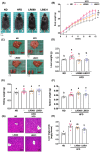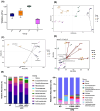Lactobacillus rhamnosus 069 and Lactobacillus brevis 031: Unraveling Strain-Specific Pathways for Modulating Lipid Metabolism and Attenuating High-Fat-Diet-Induced Obesity in Mice
- PMID: 38973907
- PMCID: PMC11223209
- DOI: 10.1021/acsomega.4c02514
Lactobacillus rhamnosus 069 and Lactobacillus brevis 031: Unraveling Strain-Specific Pathways for Modulating Lipid Metabolism and Attenuating High-Fat-Diet-Induced Obesity in Mice
Abstract
Obesity is a global health crisis, marked by excessive fat in tissues that function as immune organs, linked to microbiota dysregulation and adipose inflammation. Investigating the effects of Lactobacillus rhamnosus SG069 (LR069) and Lactobacillus brevis SG031 (LB031) on obesity and lipid metabolism, this research highlights adipose tissue's critical immune-metabolic role and the probiotics' potential against diet-induced obesity. Mice fed a high-fat diet were treated with either LR069 or LB031 for 12 weeks. Administration of LB031 boosted lipid metabolism, indicated by higher AMP-activated protein kinase (AMPK) and acetyl-CoA carboxylase (ACC) phosphorylation, and increased the M2/M1 macrophage ratio, indicating LB031's anti-inflammatory effect. Meanwhile, LR069 administration not only led to significant weight loss by enhancing lipolysis which evidenced by increased phosphorylation of hormone-sensitive lipase (HSL) and adipose triglyceride lipase (ATGL) but also elevated Akkermansia and fecal acetic acid levels, showing the gut microbiota's pivotal role in its antiobesity effects. LR069 and LB031 exhibit distinct effects on lipid metabolism and obesity, underscoring their potential for precise interventions. This research elucidates the unique impacts of these strains on metabolic health and highlights the intricate relationship between gut microbiota and obesity, advancing our knowledge of probiotics' therapeutic potential.
© 2024 The Authors. Published by American Chemical Society.
Conflict of interest statement
The authors declare no competing financial interest.
Figures







Similar articles
-
Anti-obesity effect of Lactobacillus rhamnosus LS-8 and Lactobacillus crustorum MN047 on high-fat and high-fructose diet mice base on inflammatory response alleviation and gut microbiota regulation.Eur J Nutr. 2020 Sep;59(6):2709-2728. doi: 10.1007/s00394-019-02117-y. Epub 2019 Oct 28. Eur J Nutr. 2020. PMID: 31659451
-
Dysregulation of lipolysis and lipid metabolism in visceral and subcutaneous adipocytes by high-fat diet: role of ATGL, HSL, and AMPK.Am J Physiol Cell Physiol. 2010 Apr;298(4):C961-71. doi: 10.1152/ajpcell.00547.2009. Epub 2010 Jan 27. Am J Physiol Cell Physiol. 2010. PMID: 20107043
-
Antiobesity Effect of Novel Probiotic Strains in a Mouse Model of High-Fat Diet-Induced Obesity.Probiotics Antimicrob Proteins. 2021 Aug;13(4):1054-1067. doi: 10.1007/s12602-021-09752-0. Epub 2021 Feb 10. Probiotics Antimicrob Proteins. 2021. PMID: 33569747
-
Ramulus Mori (Sangzhi) Alkaloids Ameliorate Obesity-Linked Adipose Tissue Metabolism and Inflammation in Mice.Nutrients. 2022 Nov 27;14(23):5050. doi: 10.3390/nu14235050. Nutrients. 2022. PMID: 36501080 Free PMC article.
-
Novel insights of dietary polyphenols and obesity.J Nutr Biochem. 2014 Jan;25(1):1-18. doi: 10.1016/j.jnutbio.2013.09.001. J Nutr Biochem. 2014. PMID: 24314860 Free PMC article. Review.
Cited by
-
Lactobacillus plantarum alleviates high-fat diet-induced obesity by altering the structure of mice intestinal microbial communities and serum metabolic profiles.Front Microbiol. 2024 Aug 30;15:1425764. doi: 10.3389/fmicb.2024.1425764. eCollection 2024. Front Microbiol. 2024. PMID: 39282560 Free PMC article.
-
Updated Insights into Probiotic Interventions for Metabolic Syndrome: Mechanisms and Evidence.Probiotics Antimicrob Proteins. 2025 May 7. doi: 10.1007/s12602-025-10554-x. Online ahead of print. Probiotics Antimicrob Proteins. 2025. PMID: 40332670 Review.
-
Lactobacillus brevis-Derived Exosomes Enhance Skin Barrier Integrity by Upregulating Key Barrier-Related Proteins.Clin Cosmet Investig Dermatol. 2025 May 8;18:1151-1162. doi: 10.2147/CCID.S512793. eCollection 2025. Clin Cosmet Investig Dermatol. 2025. PMID: 40356846 Free PMC article.
References
-
- Tiwari A.; Balasundaram P.; Public Health Considerations Regarding Obesity; StatPearls Publishing: Treasure Island, FL, 2023. - PubMed
LinkOut - more resources
Full Text Sources
